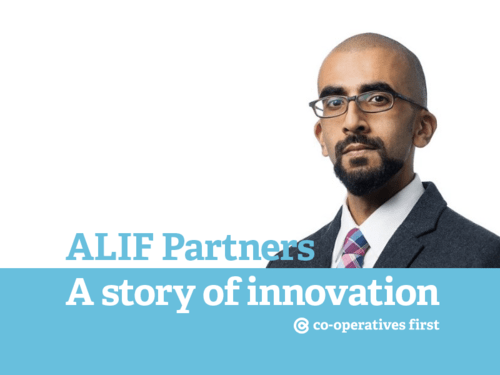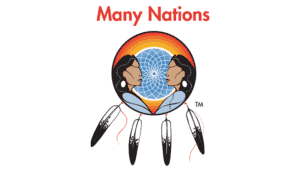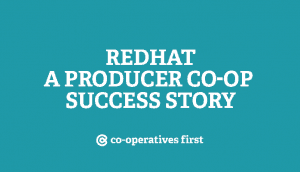Senior Partner, Omar Yaqub of ALIF Partners
Co-operative businesses are more than grocery stores and gas stations. You can find co-operative businesses in every sector, performing well in some of the most challenging markets. Today, we’re seeing innovative uses of the model, as well as innovations on the model, used to support impressive businesses competing regionally, nationally and internationally.
Platform co-operatives, like Stocksy, or New Generation co-operatives, like Westlock Terminals, are examples of this type of innovation and the versatility of the model. We’ve recently bumped into another impressive innovation on the model in the form of ALIF Partners, which is a consulting firm based in Edmonton, Alberta.
ALIF’s upper management consists of three partners and a senior advisor, and the business supports about 14 payroll staff and numerous contract consultants. ALIF offers a broad range of business development supports, such as strategy, market research and brand development.
ALIF Partners and Co-operatives First partnered on a project working with a northern community working to create and fund a co-operative. While working with these forward-thinking entrepreneurs, we were surprised to learn that the consulting business itself was a co-operative. So, we asked one of the three partners, Omar Yaqub, about why they chose the co-operative model and the impacts this choice has made on their operations and business. His answers might surprise you.
Please describe ALIF Partners. What do you do every day?
ALIF’s approach is based on conscientious marketing, practical hands-on research, and human-centred design. When we started ALIF Partners, we wanted to align our creative strengths with our consulting expertise in a way that supported our clients to be the best in the industry and make a meaningful impact. For this reason, we intentionally focus on the For-Benefit sector or Fourth Sector, which integrates social and environmental aims with business approaches. For-Benefit organizations are not defined by profit or its absence but by quality and impact.
In this way, we partner with organizations providing strategic mentorship to innovate and grow. We also work with businesses in times of transition to unite leadership around a clear organizational culture. We utilize our expertise in brand strategy to help clients put branding strategy before visual identity, creating meaningful brand experiences that deliver on brand promises and increase performance.
This happens through in-depth research and creative insight that aligns business and creative strategy development to solve organizational challenges, integrating innovative and evidence based practices such as human-centered design.
In the last few months we’ve…
- Helped a remote First Nation plan and unlock funding for a community centre & the first Band Development Co-op in Canada
- Developed a customized labour study from primary sources (interviews & traffic data, not just StatsCan)
- Researched and designed a report on the history of the human services sector
- Created a customized pastoral care training program
- Built an employee engagement strategy for a major construction firm
- Created brand strategy, visual identity and communication strategy for for-profits and non-profits.
In what ways has being a worker co-operative influenced how you do business?
Worker co-operative principles are deeply embedded in our firm’s culture. Workers are expected to act and behave like owners. They are responsible for the assets of the firm and its future growth. That means that our staff are conscientious about every aspect of the work they do. They’re careful about how they spend their time, the quality of work they produce, and how they relate to each other. Workers understand that their compensation is directly tied to the work they do. Patronages and bonuses are a component of compensation, the harder they work, the better the firm does and the more they benefit from associating with the firm. They eat what they grow, in a sense.
We’ve also found benefit in the co-operative model as a business model for the organizations we work with. Since we operate in the for-benefit sector, which defines organizations not by profit or its absence, but by quality and impact, the co-operative model is a natural fit for many of our clients. For example, we’re helping a remote First Nation develop a community development co-operative. The co-operative will build critical infrastructure such as health services and education, and will support local businesses in order to create wealth and jobs in the community. The co-operative model was selected because it aligns with traditional Indigenous values of consensus-building and equality.
What benefits did you and your partners see in the business model that helped you decide on the co-operative model over another business model?
We were highly motivated by the 7 Cooperative Principles. We felt our values were reflected in them. We wanted to be a different kind of firm; one that emphasized quality, transparency and honesty – a co-op felt like it was the best fit for who we were and the kind of people we wanted to work with.
There’s a great support network of professionals and organizations who specialize in co-operative development, and we wanted their expertise and guidance.
Are there advantages to using this model beyond an ideological or strictly social aspect?
Ownership, profit-sharing, and democratic control are empowering benefits which improve staff retention and serve to attract high-calibre individuals. This is especially beneficial in professional services, such as consulting, an industry with high staff turnover.
How would you describe the relationship between the three partners – are there risks to organizing this way that others should be aware of?
The three founders of the firm have clearly defined roles which reflect the unique skills and expertise they bring to the firm. We’re experimenting with a number of governance models in terms of the relationship between Directors of the firm, management, and staff. As a professional services firm, we have unique challenges when it comes to adapting to the co-operative model. We want to facilitate democratic control on the part of the Membership while ensuring that the strategic vision of the founders is realized.
Other professional services firms, whether they offer consulting services like we do or something else, need to carefully consider the relationship of Directors and management before they decide to organize as a co-operative.
Has choosing this model created any barriers for scaling the business or in attracting business for ALIF Partners?
No. We did think at one point that we’d be limited in how much the business could scale if ownership was only in the hands of the workers. Usually to scale you need financing from third-parties. However, as we looked more into the concept of patronage we realized that what it does is enable a more honest evaluation of a worker’s contribution to the firm. That means the business will scale as fast as it needs to. That might seem a little vague, so to put it simply: the harder the staff works, the more the business will make, and the more they’ll get out of the firm. They benefit from the firm in proportion to the work they put in, so nobody loses.
What is “Conscientious Marketing”?
ALIF’s approach to marketing is focused on the for-benefit sector. Conscientious marketing has a social purpose. Rather than merely selling products and creating catchy slogans. Conscientious marketing is about helping people to help themselves. People and their motivations are studied in order to create long-term, multi-directional, and sustainable relationships. ALIF takes a tailored approach where one size does not fit all. ALIF’S marketing solutions are based on understanding people’s needs and helping them to achieve their goals for themselves and for their community.
Describe what “Hands-on Research” means?
The best research is born out of genuine curiosity and a willingness to conduct archival research, first person interviews, investigative analysis and collaborative assessment. ALIF leverages historical researchers, archivists, and facilitators to produce research that is interesting, human and rigorously backed.
What does Human-Centered Design mean for ALIF Partners?
Human-Centered Design is a creative approach to problem solving that informs ALIF’s methodologies. It is a process that starts with people and ends with solutions that are tailored to suit the needs of an organization. Human-Centered Design emphasizes an empathetic approach that engages the staff, stakeholders, organizational partners, and the community to generate strategies to implement solutions. ALIF Partners will tailor strategies to the organization and leaders’ interests.
Can you provide a few samples of your work?
Smith’s Landing First Nation Environmental Scan alifpartners.com/SLFN-EnvScan
A History of Edmonton Human Services Sector alifpartners.com/ECVOHistory
Community Newsletter alifpartners.com/SLFNNewsletter
Labour Study for Wetaskiwin alifpartners.com/JEDI-Labour
Morning stand-up meeting in the ALIF Bullpen.






